.jpg )
Five family sedans take five different approaches to the same challenges. Which works best?
Can’t wait to see the final scores? Jump to the verdict now.
REMEMBER the scene from that Keanu Reeves cult flick filmed in Sydney? When Neo starts to believe, everything turns to tumbling green letters and he “sees the Matrix”? That’s how I feel right now. Stretched before me in the morning gloom sit five family sedans that moments ago had appeared as disparate as a schizophrenic’s memoirs. Then the penny dropped and the past, present and future of the Australian motoring industry collided.
You can still buy a traditional, indigenous family sedan for the same money as an imported mid-sizer.
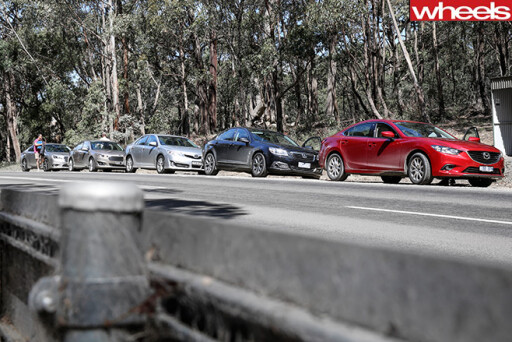 For now. It’s been a constant of the Aussie landscape for decades, and it’s a realisation that not only throws this comparison into sharper focus, it magnifies five very different approaches to nailing the family sedan brief.
For now. It’s been a constant of the Aussie landscape for decades, and it’s a realisation that not only throws this comparison into sharper focus, it magnifies five very different approaches to nailing the family sedan brief.
Five family cars, five recipes
Every car here follows a different recipe, be it a naturally aspirated or turbo four-pot, a V6 or boxer six, with a mix of front-drive, rear-drive and all-wheel drive. The one thing these sedans share is a $40K price tag, all five landing within a couple of grand of one another thanks to big price cuts at Ford and Subaru.
Subaru’s sixth-generation Liberty is a whopping $14K cheaper than its predecessor in this 3.6R Premium guise, and to say it carries big expectations, particularly for Wheels readers, is an understatement. As a two-time Car of the Year winner, the Liberty nameplate was once renowned for its Euro-bashing dynamics and unique Japanese character stemming from a combination of horizontally opposed engines and all-wheel drive.
 But all is not well in Liberty-land. A push towards the American market saw the previous generation not only grow bigger, uglier and less charismatic, it failed to match its predecessor’s sales Down Under. Of this group, the Liberty is easily the smallest player on the sales charts, its 926 sales to the end of November 2014 both a shadow of its former glory and comprehensively crushed by the Mazda 6 (5486), Falcon (5771), Camry (19,670) and Commodore (28,194). So this Liberty needs to deliver.
But all is not well in Liberty-land. A push towards the American market saw the previous generation not only grow bigger, uglier and less charismatic, it failed to match its predecessor’s sales Down Under. Of this group, the Liberty is easily the smallest player on the sales charts, its 926 sales to the end of November 2014 both a shadow of its former glory and comprehensively crushed by the Mazda 6 (5486), Falcon (5771), Camry (19,670) and Commodore (28,194). So this Liberty needs to deliver.
As does Ford’s FG-X Falcon. Its $40,100 price tag is $6225 less than the outgoing FG, meaning Ford’s G6E Ecoboost has never made more sense, nor looked so good. It is undoubtedly one of the best-looking variants in the refreshed FG-X range thanks to its elegant chrome grille, crisp LED-encrusted nose and fashionable 18-inch alloys.
Ford hopes the repositioned G6E will steal sales from its freshly updated mortal enemy, Holden’s excellent Calais. Now sporting minor equipment upgrades and a new, more progressive steering calibration, the Calais continues to be the sweet spot of the VF range. Not only does its sumptuous ride, muscular performance and modern interior make it one of Australia’s most convincing family sedans, it’s Wheels’ benchmark for this five-seat class.
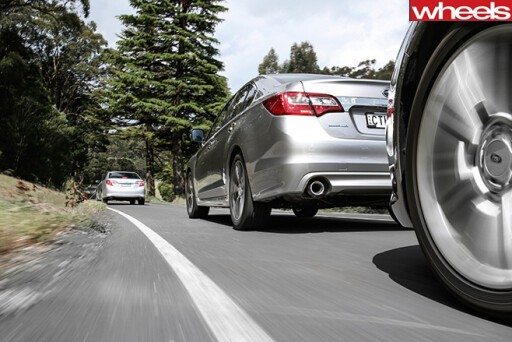 Mazda’s sporty ‘SkyActiv’ 6 is also a Wheels comparison winner, yet the same can’t be said of the Toyota Camry. It is the oldest car here by some margin (launched in December 2011, although a heavily updated version will arrive later this year), and a lack of a distinct personality has never made it a Wheels favourite. Still, 18 years as Australia’s best-selling mid-sizer means it must be doing something right.
Mazda’s sporty ‘SkyActiv’ 6 is also a Wheels comparison winner, yet the same can’t be said of the Toyota Camry. It is the oldest car here by some margin (launched in December 2011, although a heavily updated version will arrive later this year), and a lack of a distinct personality has never made it a Wheels favourite. Still, 18 years as Australia’s best-selling mid-sizer means it must be doing something right.
Floor it: here’s what happens
It’s a motley crew of high achievers then, but it’s the Subaru, and its huge weight of expectation, that garners the most interest when we meet at the drag strip. Boasting a carryover 191kW/350Nm 3.6-litre horizontally opposed six, the biggest mechanical change to the streamlined Liberty range is its transmission, which is now CVT only. Intuitive, refined and unobtrusive, it’s a drivetrain best summed up in one word: smooth. Even in high temperatures that saw the other four cars struggle to match their personal bests, the Liberty came close to its 7.2sec 0-100km/h claim with a sprint of 7.3sec and a 400m time of 15.3sec. Subaru’s premium drivetrain feels strong and never rushed, yet as punchy and flexible as it is, it’s still no match for the big Aussie V6 in the Calais.
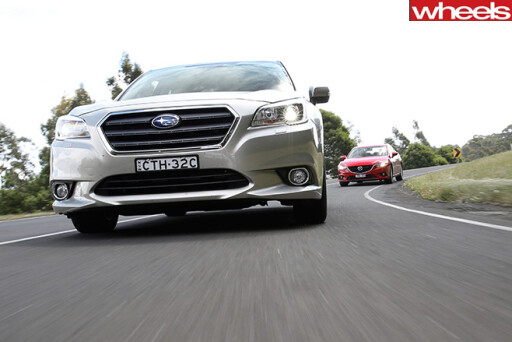 At the strip, the Holden is in a league of its own, not only setting the fastest 0-100km/h and quarter-mile times (7.1sec and 15.1sec respectively), but offering a level of engagement lacking in the Subaru. Where the Japanese car is silky and super-refined, the louder Aussie six is more involving when worked hard, and sharper off the line. It’s a performance gulf that widens in the real world, where Calais nails the luxury/sports brief. It’s intuitive and responsive at the limit thanks to an excellent gearbox tune and a Sport mode that’s willing to hold gears. And it’s quiet, torquey and muscular around town. The one letdown is induction sound, which can be thrashy and uncultured at thetop of the rev range.
At the strip, the Holden is in a league of its own, not only setting the fastest 0-100km/h and quarter-mile times (7.1sec and 15.1sec respectively), but offering a level of engagement lacking in the Subaru. Where the Japanese car is silky and super-refined, the louder Aussie six is more involving when worked hard, and sharper off the line. It’s a performance gulf that widens in the real world, where Calais nails the luxury/sports brief. It’s intuitive and responsive at the limit thanks to an excellent gearbox tune and a Sport mode that’s willing to hold gears. And it’s quiet, torquey and muscular around town. The one letdown is induction sound, which can be thrashy and uncultured at thetop of the rev range.
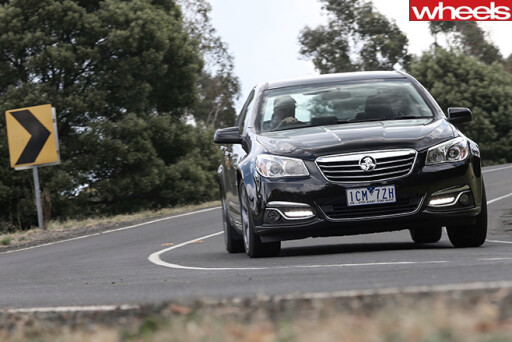 Somewhat surprisingly, the Holden’s soundtrack is trumped by the turbo Falcon’s. Proving engine size doesn’t matter, the 2.0-litre G6E is only a tenth behind the V6 Calais to 100km/h and over the standing 400m, its impressive performance underscored by a sugary blend of induction sweetness and turbo whistle. Again, like the Liberty, the Falcon uses a carryover engine with unchanged outputs (179kW/353Nm), but it’s a cultured, rev-hungry unit with plenty of low-down shove and a meaty mid-range. The added bonus is improved chassis balance thanks to the lighter four-cylinder donk, but there’s no escaping the fact the G6E’s drivetrain feels foreign. After decades of six-cylinder Falcons, sitting in the G6E’s largely unchanged interior and hearing a turbo four zing and pop under the bonnet, just as it does in the Range Rover Evoque that shares the same engine, takes some getting used to.
Somewhat surprisingly, the Holden’s soundtrack is trumped by the turbo Falcon’s. Proving engine size doesn’t matter, the 2.0-litre G6E is only a tenth behind the V6 Calais to 100km/h and over the standing 400m, its impressive performance underscored by a sugary blend of induction sweetness and turbo whistle. Again, like the Liberty, the Falcon uses a carryover engine with unchanged outputs (179kW/353Nm), but it’s a cultured, rev-hungry unit with plenty of low-down shove and a meaty mid-range. The added bonus is improved chassis balance thanks to the lighter four-cylinder donk, but there’s no escaping the fact the G6E’s drivetrain feels foreign. After decades of six-cylinder Falcons, sitting in the G6E’s largely unchanged interior and hearing a turbo four zing and pop under the bonnet, just as it does in the Range Rover Evoque that shares the same engine, takes some getting used to.
 But if the Falcon’s noise is unfamiliar, the Mazda’s throaty 2.5-litre four couldn’t be more on-brand. It remains one of the best iterations of Mazda’s SkyActiv technology, and it screams sporting intent the moment you jump behind its leather-trimmed wheel. Wind it up on the brake and the gutsy 6 rockets from a standing start, its bristling performance accompanied by an exhaust note that’s easily the most involving here. But it’s the way the grunty petrol channels its torque that’s most impressive, pulling strongly and cleanly from as low as 1200rpm in top gear. Due to the hot conditions, the 6’s 0-100km/h sprint of 8.1sec is well down on the 7.6sec we clocked last year, but it’s still a number that embarrasses the Camry.
But if the Falcon’s noise is unfamiliar, the Mazda’s throaty 2.5-litre four couldn’t be more on-brand. It remains one of the best iterations of Mazda’s SkyActiv technology, and it screams sporting intent the moment you jump behind its leather-trimmed wheel. Wind it up on the brake and the gutsy 6 rockets from a standing start, its bristling performance accompanied by an exhaust note that’s easily the most involving here. But it’s the way the grunty petrol channels its torque that’s most impressive, pulling strongly and cleanly from as low as 1200rpm in top gear. Due to the hot conditions, the 6’s 0-100km/h sprint of 8.1sec is well down on the 7.6sec we clocked last year, but it’s still a number that embarrasses the Camry.
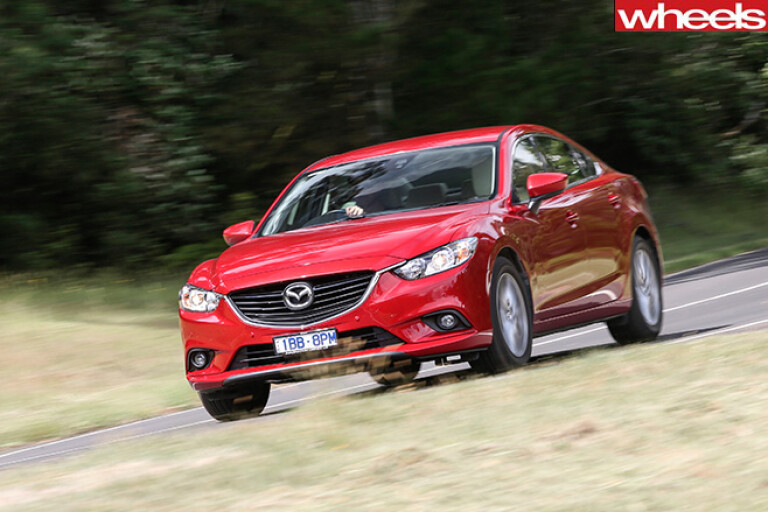
On paper, the Toyota is a facsimile of the Mazda – both have atmo fours of the same capacity and front-wheel drive – yet when it comes to performance, engagement and character, the two Japanese cars are poles apart. Where the Mazda is rorty and muscular, the Toyota feels lacklustre at the strip. It’s by far the slowest of the group, both from a standing start and on the move, with the Camry’s 80-120km/h time of 6.4sec a full second slower than the 6’s and almost two seconds slower than the quickest car here, the Calais (4.5sec).

However, it would be wrong to dismiss the Camry’s drivetrain as insipid. In isolation, Toyota’s locally made 2.5-litre four is liveable, and while its performance is middle of the road at best, in city traffic the Camry does not feel underpowered.
Let’s get into the country
There is a place where the Toyota exceeds expectations, though – country Aussie roads. Granted, when you first slip behind the Camry’s cheap-feeling, oversized steering wheel, initial impressions aren’t positive. You sit on flat leather seats in a cabin dominated by hard plastics and cheap fonts. It’s easily the least polished interior here and has a hire-car ambience that betrays what Camrys so often do.
Things don’t improve much at slow speed, either. The unladen urban ride isn’t great, with a knobbliness you don’t expect, and its heavily weighted steering feels cumbersome and lazy, with a slow rack (3.2 turns lock-to-lock) often demanding armfuls of lock. Push through this on the open road, though, and you’ll discover that beneath the steering’s lethargy and the ride’s lack of low-speed absorbency, there’s a sweet chassis you can actually lean on. It has a fundamental balance that rewards the more you push, which is something few Camry drivers are likely to discover. For a car that most will buy for its space and A-to-B dependability, it’s a disappointing reality that the less you ask of the Camry, the less it gives.

The opposite applies with the Subaru. Drive the Liberty on the freeway or quiet country roads and you’re almost overwhelmed by its smoothness. The ride on 18-inch wheels is reasonably supple, its drivetrain is hushed and, thanks to a deep glasshouse and an A-pillar that’s now 50mm further forward, vision is excellent. But where the Liberty excels superficially, things unravel the harder you drive.
The Liberty struggles to absorb sharp imperfections on rough Aussie roads, and the steering, which feels well weighted on the freeway, if rather numb, suddenly feels too light at the straight ahead and almost anaesthetised. Of course, Subaru’s much touted all-wheel-drive system means the Liberty has loads of grip, but any confidence this brings is eroded by the dead steering and unsettled body control. What the sixth-gen Liberty lacks is the crispness of feedback and lightness of touch that made its distant predecessors so rewarding, meaning that at the limit it feels aloof rather than encouraging.
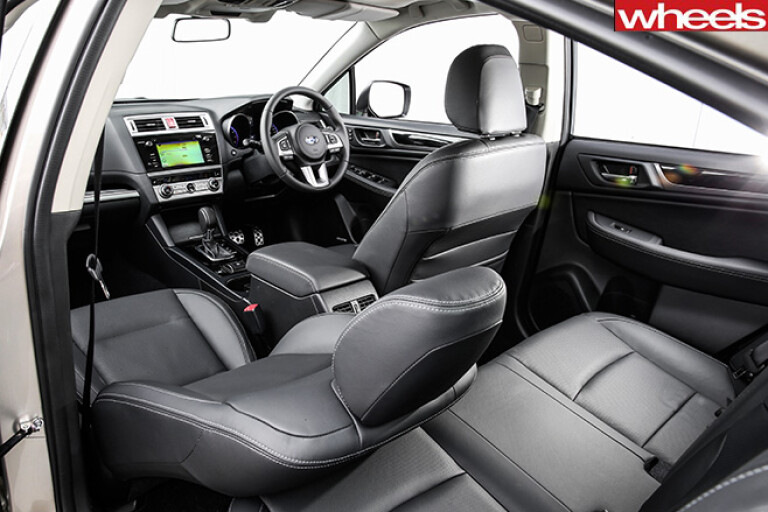
Things couldn’t be more different in the Mazda. Where the Liberty shields you from the action, everything in the 6 is in your face, from its ride and handling to its road noise and engine rasp. It feels connected and unashamedly sporty, with a ride that’s noticeably firmer but also controlled and deft in its bump absorption and compliance. A well-sorted chassis and keen steering boost driver confidence, yet the 6 is far from perfect. It’s easily the noisiest of the group, with high amounts of tyre roar and wind rustle from the mirrors, and while the steering is mostly well weighted, it can feel mushy and inconsistent off centre. The lack of a Sport mode, especially in a car that champions sporting pretensions, is another oversight and one exposed on the winding roads of our test route, where it was possible to catch the engine out in tight, uphill corners. Still, the 6 always feels invigorating, a character trait shared by the Ford.
The Falcon’s gem of a drivetrain shaves weight from its nose and surprises with its engaging character and sparkling performance. Push the G6E hard and the lighter four-pot engine is immediately obvious through a pointy front end and light steering that’s communicative and so responsive it verges on nervous. Take the time to acclimatise, though, and the Falcon rewards you with a chassis balance and body control that, while clearly engineered towards comfort, can also be fun. Admittedly, the crisp steering can feel overly light at the limit, but the G6E blends a level of performance and connection that, dynamically at least, is almost ideal for Australian roads.
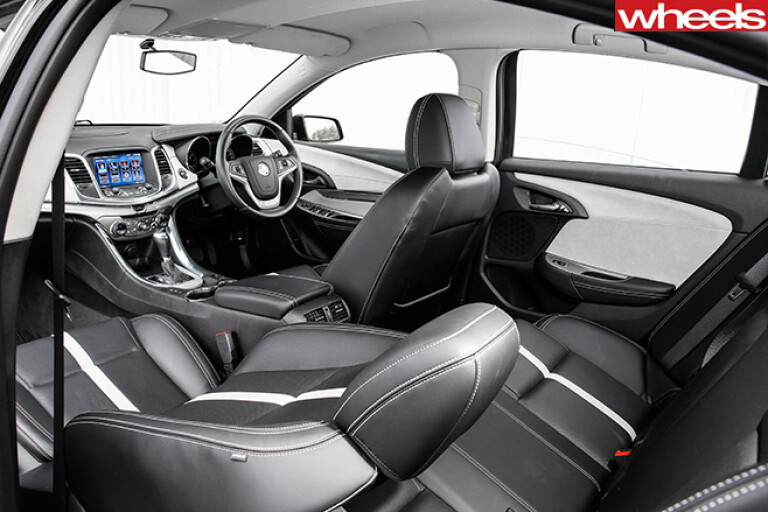
However, the Falcon still can’t match the dynamic verve and suppleness of the most polished car here, the Calais. Boasting ride quality and body control that are both first class, the Calais is quiet and forgiving on coarse, pot-marked roads yet, thanks to its muscular V6 and superb balance, is engaging enough to offer real driver involvement. Improved steering weighting and progression from straight ahead fixes what was a minor achilles heel in the original VF, with the Calais boasting an excellent handling package honed for Aussie conditions.
So, how happy will your passengers be?
The Holden is the best all-rounder here, and not just dynamically. Practically spot-on in its packaging, the Calais has the most comfortable seats front and rear, is the quietest, and also the most technically advanced thanks to its reversing camera, blind-spot monitoring and auto park assist. And as far as interiors go, the Calais is in a class of its own. Beautifully appointed and with a near-ideal driving position, the Calais’s interior ambience transcends what you expect from a $40K car and totally outshines its Falcon rival.

Climb into the G6E and it’s clear the interior is where Ford skimped the most when it came to the new FG-X range. Yes, the Blue Oval’s new SYNC2 infotainment system brings a much-needed dose of modernity, but there’s no escaping the G6E’s inherent FG-ness. You get the same messy central stack, unfortunate plastics and, worse, the same flawed driving position where you sit too high and the wheel is too low, meaning you need to tilt the seat rearwards to compensate. It’s a seven-year-old interior that feels like a seven-year-old interior, with none of the textural or packaging finesse you get in the Calais, nor the same level of comfort.
Still, in terms of space the Falcon outclasses the Mazda. Despite riding on a near identical wheelbase (2838 vs 2830mm), the 6 feels cramped and compromised against the big, airy Aussie. The 6’s interior has vastly superior fit and finish, and rear headroom is still decent despite its sloping roofline, but for all its emphasis on style, the 6 isn’t sexy enough to make up for its compromised packaging.

Despite its lacklustre dynamics, it’s inside where the Liberty claws back some ground. Open, spacious and beautifully appointed, the Liberty’s interior is one of Subaru’s best in years, combining a neatness and quality of materials, with an intuitive and beautifully integrated 5.0-inch LCD display. Passenger room front and rear is improved, despite the wheelbase remaining unchanged at 2750mm, while cabin refinement, especially at freeway speeds, is impressive. Only flat and comparatively unsupportive seats let down the Liberty’s interior.
If only the Camry had so few foibles. It’s inside where the Camry falls behind more than any other area with its inexpensive materials, clumsy ergonomics and dated infotainment system failing to emulate the polish of the other four. Admittedly, a hefty reskin later this year may address these issues, but for now the ageing Camry’s lack of design flair, personality and, surprisingly, efficiency (on test the four-cylinder Camry drank 11.4L/100km, a number only marginally better than the V6 Calais’s 11.6L/100km) sees it trail its family sedan rivals. Honest and unassuming it may be, but that isn’t enough in 2014. Not for 40 grand.
Calais leads, Camry trails. And the rest?
Camry’s defeat is far from a whitewash, though. It’s damning for Subaru that there are areas, such as country-road ride and body control, where its new Liberty is outclassed by the Camry, a result no one would have predicted at the start of this test. With its disinterested dynamics, lumpy suspension tune and hefty 12.6L/100km thirst, the Liberty 3.6R Premium has become a slick showroom car that triumphs its value-for-money credentials over its ability to be a dynamic flagship for Subaru. A Euro-killer it’s not.
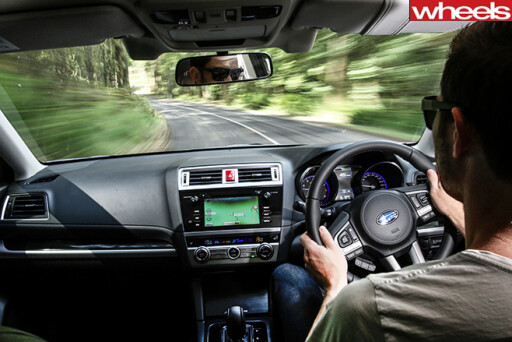 Which leaves us with the Falcon, the Mazda 6 and the toughest decision of this test.
Which leaves us with the Falcon, the Mazda 6 and the toughest decision of this test.
There’s no denying that everything Ford has touched on the new G6E is an improvement. It looks premium (on the outside), rides beautifully and, thanks to its torquey turbo four-pot and impressive agility, conveys an eagerness and sportiness that surpasses its cushy, family-barge image.
But, try as it might, it just can’t escape the flaws inherited from the FG. With Ford having so little money to spend, the reality is the FG-X was never going to be anything more than fresh tinsel on an ageing tree. And if you drive enthusiastically like we did, don’t expect class-leading economy, either. Still, in this spec, we could understand why someone would make a heart-over-head decision and buy the Falcon G6E Ecoboost over the Mazda.
 On paper, though, it’s the Mazda that snags second place. Not only was it easily the most economical at 9.4L/100km, but its blend of rorty performance, quality build and interior comfort makes the car from Hiroshima a rock-solid all-rounder. Where it falls short is its lack of overall polish, which is what the Holden does best.
On paper, though, it’s the Mazda that snags second place. Not only was it easily the most economical at 9.4L/100km, but its blend of rorty performance, quality build and interior comfort makes the car from Hiroshima a rock-solid all-rounder. Where it falls short is its lack of overall polish, which is what the Holden does best.
Head and shoulders above the others when it comes to packaging, refinement and interior comfort, it’s almost impossible to find something the Calais doesn’t do well. Its vocal V6 sounds unrefined when driven hard, but it’s gutsy enough that you can simply waft along on its torque, while enjoying its surprising economy.
As an overall package, the Calais decimates its rivals, with an enticing blend of economy, value and effortless performance that not only makes it the best variant in Holden’s VF range, but by extension the best family car ever made in Australia.
Value equation
CAR manufacturers love to sex up their press cars by ticking every option in the catalogue, but not here. Each model in this quintet is stock standard, with the only options being premium paint on the Holden and Camry and floor mats in the Mazda.
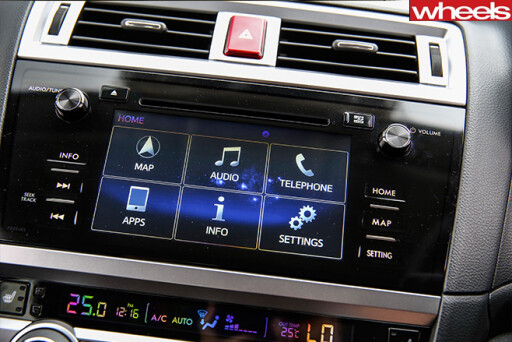 Still, all is not even when it comes to standard kit. While all five cars boast leather interiors, big LCD infotainment systems, reversing cameras and cruise control, only the Japanese trio offer paddle shifts on their leather-trimmed wheels and the Subaru is the only one with keyless entry and adaptive cruise control.
Still, all is not even when it comes to standard kit. While all five cars boast leather interiors, big LCD infotainment systems, reversing cameras and cruise control, only the Japanese trio offer paddle shifts on their leather-trimmed wheels and the Subaru is the only one with keyless entry and adaptive cruise control.
Ford, Toyota and Subaru include auto wipers, while only the Toyota and Holden have blind-spot monitoring. The Calais also offers Auto Park Assist, but misses out on sat-nav (a $750 option), which is standard across the other four.
Verdict
 Ford Falcon G6E Ecoboost
Ford Falcon G6E Ecoboost
Price as tested: $41,110
NCAP rating: 5 stars (Aus)
Fuel economy: 11.7L/100km (test average)
Acceleration: 0-100km/h: 7.3sec (tested)
Plus: Engaging, punchy turbo four; keen dynamics; direct steering; nice ride
Minus: Inherited FG flaws; old interior; engine thirsty when driven hard
Verdict: 7.0/10
 Holden Calais
Holden Calais
Price as tested: $41,430
NCAP rating: 5 stars (Aus)
Fuel economy: 11.6L/100km (test average)
Acceleration: 0-100km/h: 7.1sec (tested)
Plus: Luscious ride and handling; premium interior; all-round polish; great value
Minus: V6 sounds raucous at high revs; doesn’t get steering wheel paddles
Verdict: 8.5/10
 Mazda 6 Touring
Mazda 6 Touring
Price as tested: $39,170
NCAP rating: 5 stars (Aus)
Fuel economy: 9.4L/100km (test average)
Acceleration: 0-100km/h: 8.1sec (tested)
Plus: Sporty, engaging character; excellent driving position; chassis balance
Minus: Road noise; shallow boot; patchy interior; auto needs a ‘sport’ mode
Verdict: 7.5/10
 Subaru Liberty 3.6R
Subaru Liberty 3.6R
Price as tested: $41,990
NCAP rating: 5 stars (Aus)
Fuel economy: 12.6L/100km (test average)
Acceleration: 0-100km/h: 7.3sec (tested)
Plus: Silky-smooth drivetrain; interior quality; refinement; newfound value
Minus: Lacks involvement and character; numb steering; economy; ride
Verdict: 6.0/10
 Toyota Camry Atara SL
Toyota Camry Atara SL
Price as tested: $40,440
NCAP rating: 5 stars (Aus)
Fuel economy: 11.4L/100km (test average)
Acceleration: 0-100km/h: 9.2sec (tested)
Plus: Reasonable drivetrain; four-up ride quality; country-road balance; space
Minus: Low-rent interior; lazy steering; too-big steering wheel; feels cheap
Verdict: 5.0/10



COMMENTS